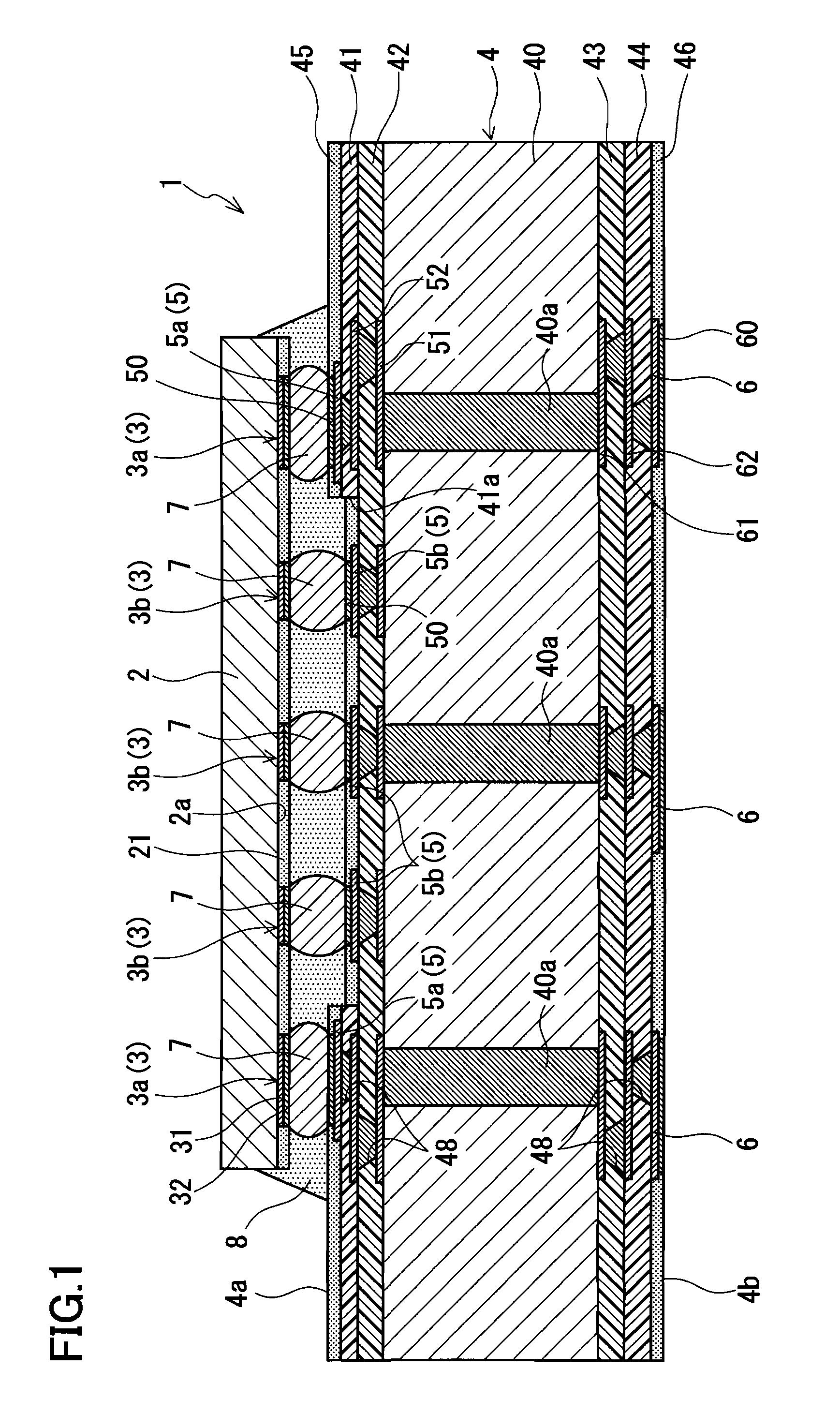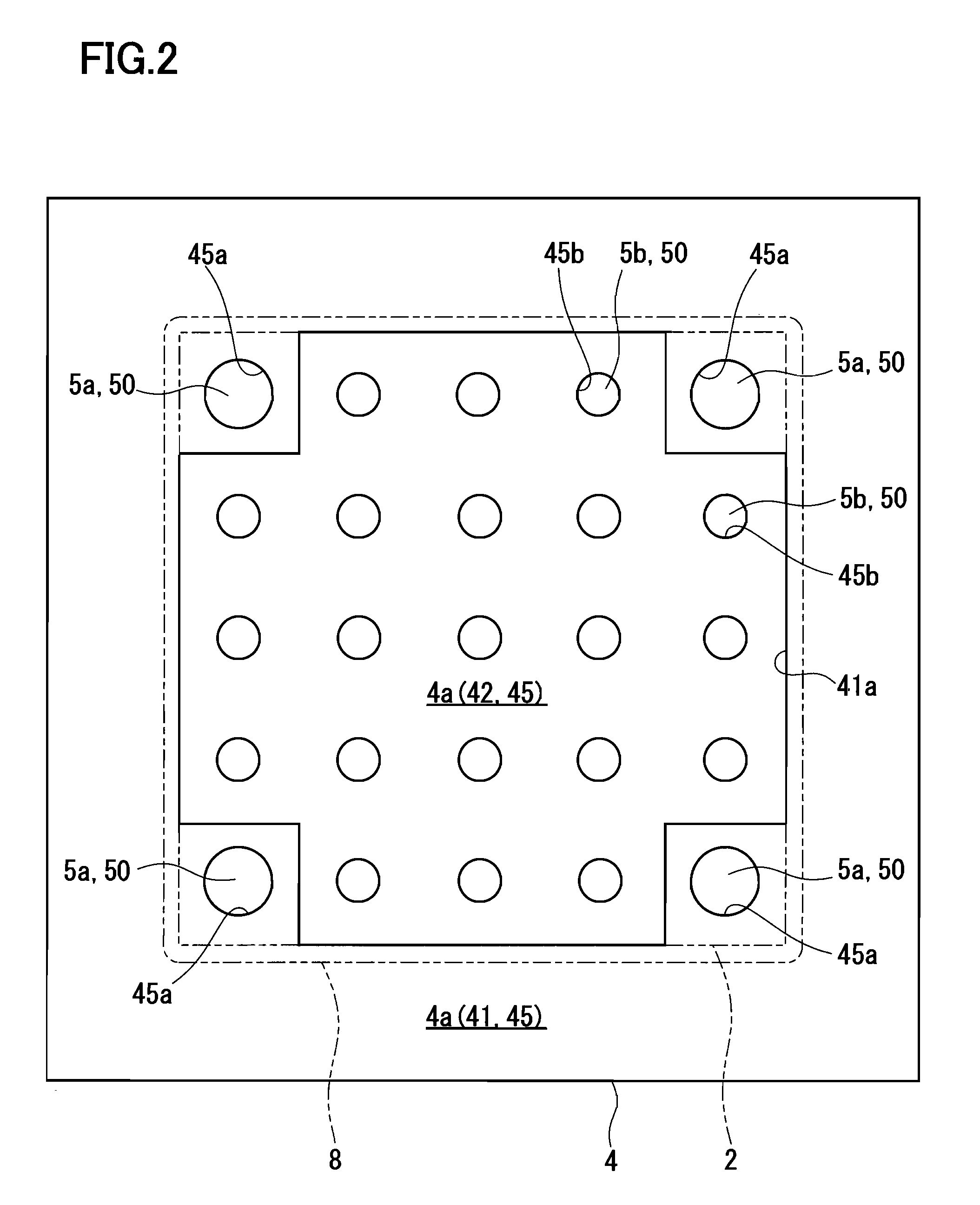Semiconductor device, and method of manufacturing multilayer wiring board and semiconductor device
a semiconductor and multi-layer technology, applied in the direction of dielectric characteristics, conductive pattern formation, thermoplastic polymer dielectrics, etc., can solve the problems of significant reduction in yield, significant difference in thermal expansion coefficient between semiconductor chips and multi-layer wiring boards, and conventional semiconductor packages using lead frames are approaching their limits of miniaturization, so as to prevent cracks effectively, reduce stress applied to these bumps, and prevent cracks
- Summary
- Abstract
- Description
- Claims
- Application Information
AI Technical Summary
Benefits of technology
Problems solved by technology
Method used
Image
Examples
example 1
[0094]In Example 1, the semiconductor chip 2 of 8.0 mm×8.0 mm was used. The numbers of the electrode pads 3, the connection pads 5, and the solder bumps 7 were 1600 respectively (pad pitch: 180 μm). A glass epoxy substrate was used as the core substrate 40. Polyphenylene ether was used as the thermoplastic resin constituting the first insulating layer 41, and an epoxy resin containing 50 volume % of spherical silica (inorganic filler) having an average particle diameter of 5 μm was used as the thermosetting resin constituting the second insulating layer 42. The thickness of the first insulating layer 41 formed on the top surface was 30 μm, and the thickness of the second insulating layer 42 was 45 μm. As for other conditions (such as the volumes of the solder bumps 7, the shapes and sizes of the electrode pads 3 and the connection pads 5, and the sizes of the openings 45a, 45b), those specifically exemplified in the above embodiment were applied. A semiconductor device was manufactu...
example 2
[0096]A semiconductor device was manufactured under the same conditions as those of Example 1, except that the size of the openings 45a formed at positions corresponding to the first connection pads 5a in the front-side solder resist 45 was changed from 130 μm to 90 μm of the other openings 45b.
[0097]As a result of the temperature cycle test, in the semiconductor device of Example 2, a rate of change in the connection resistance value after the 1000 cycles was +10% or less with respect to the initial resistance value. However, after the 1500 cycles, the wirings were disconnected partially. In order to identify the causes of the disconnection, a failure mode and effect analysis was carried out on the semiconductor device after being subjected to the temperature cycle test. As a result of the analysis, cracks were observed in the solder bumps 7 responsible for the disconnected wirings, and these cracks started from the points corresponding to the upper edges of the openings 45a of th...
example 3
[0098]A semiconductor device was manufactured under the same conditions as those of Example 1, except that the thickness of the first insulating layer 41 was changed to 45 μm so that the first insulating layer 41 had a thickness one half the height of the solder bumps 7 formed between the second electrode pads 3b and the corresponding second connection pads 5b.
[0099]As a result of the temperature cycle test, in the semiconductor device of Example 3, a rate of change in the connection resistance value after the 1000 cycles was +10% or less with respect to the initial resistance value. However, after the 1200 cycles, the wirings were disconnected partially. In order to identify the causes of the disconnection, a failure mode and effect analysis was carried out on the semiconductor device after being subjected to the temperature cycle test. As a result, the solder bumps 7 responsible for the disconnected wirings were pressed strongly and deformed, compared with those of Example 1, and...
PUM
| Property | Measurement | Unit |
|---|---|---|
| melting point | aaaaa | aaaaa |
| thickness | aaaaa | aaaaa |
| thickness | aaaaa | aaaaa |
Abstract
Description
Claims
Application Information
 Login to View More
Login to View More - R&D
- Intellectual Property
- Life Sciences
- Materials
- Tech Scout
- Unparalleled Data Quality
- Higher Quality Content
- 60% Fewer Hallucinations
Browse by: Latest US Patents, China's latest patents, Technical Efficacy Thesaurus, Application Domain, Technology Topic, Popular Technical Reports.
© 2025 PatSnap. All rights reserved.Legal|Privacy policy|Modern Slavery Act Transparency Statement|Sitemap|About US| Contact US: help@patsnap.com



